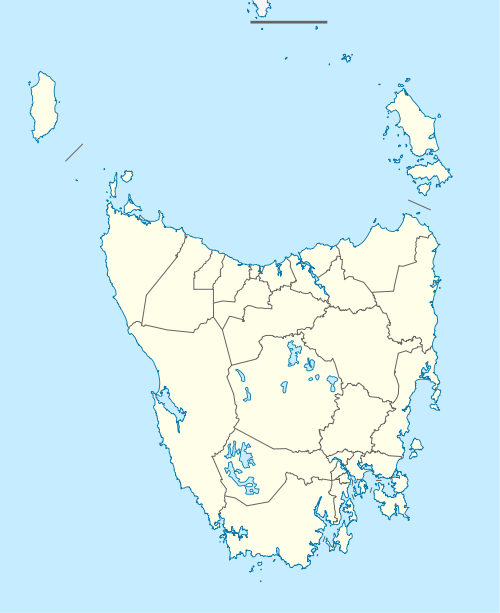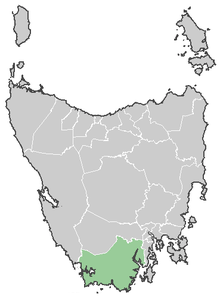Ida Bay Railway
The Ida Bay Railway is a 7-kilometre (4.3 mi), 2 ft (610 mm) narrow gauge Heritage Tramway 105 kilometres (65 mi) south of Hobart, Tasmania, Australia. The railway is currently closed but a community based not-for-profit Society has been formed to try to save the railway and reopen it to the public. The Ida Bay Railway Preservation Society Inc has approached the Tasmanian Government (owner of the railway) with a funded plan for the staged reopening of the line.

 Location of the railway | |
| Overview | |
|---|---|
| Owner | Government of Tasmania |
| Locale | Lune River |
| Transit type | Tramway |
| Headquarters | Lune River |
| Operation | |
| Operator(s) | Not currently operating |
| Technical | |
| System length | 7 km (4.3 mi)[1] |
| Track gauge | 2 ft (610 mm)[1] |
Early history of the area
Tasmanian aborigines have occupied the island for a time still not precisely measured but confirmed as tens of thousands of years. The traditional owners of the land through which the railway runs were the Lyluequonny people. This clan of the South East nation occupied an area centred on what is now called Recherche Bay. In 1793 French scientists on the d’Entrecasteaux expedition encountered the Lyluequonny. For a period in January 1793, with apparent goodwill and mutual respect, the two groups interacted and bemused each other. Because of the French journals kept at the time more is known about the Lyluequonny clan than any other in pre-European Tasmania. [2][3][4]
Following on from the arrival of the British in Tasmania in 1803, whalers, sealers and convicts were the first non-aboriginal inhabitants of the Far South. By 1822 the first land grant was made at Hythe (now Southport). The area south of Dover was reserved for timber. Convict probation stations were established at Dover and Hythe in the 1840s.
By the early 1850s timber leases were made available and mill towns emerged, including at Lune River, Ramsgate (now Cockle Creek), Hastings and Leprena. This was the start of tramways in the area initially with timber rails and horse power.
Ida Bay Railway
Around 1919 an abandoned timber tramway of the Lune River mill (Huon Timber Co.) was improved and extended by the Hydro Electric Power and Metallurgic Company. The purpose was to transport limestone from a quarry at Marble Hill just south of Hastings Cave to a jetty at Brick Point, Ida Bay. The limestone was then loaded onto river ships, taken to Electrona in North West Bay south of Hobart and used in the preparation of calcium carbide. This was mainly used for the production of acetylene gas.[5]
During 1975, freight operations ceased. Following strong community action in support of keeping the railway operating it was purchased by the Tasmanian Government in 1977 and leased to private operators as a tourist attraction. Various lease holders ran the railway for years struggling to make a profit. After a period of closure, in 2004 the line re-opened and operated until a derailment in 2018. The line is not presently at the required standard for safe operation and extensive remediation is needed to reach benchmarks set by the National Rail Safety Regulator.
Present situation
In September 2018 a train derailment highlighted the poor state of repair of the rail line, and the Ida Bay train has not run since. The lease held by the operator has been terminated and the site has reverted to control and ownership by the Tasmanian Government. The Minister for Environment and Parks is directly responsible for the site and assets of the railway at this time.
Little has been done to prevent further deterioration of the line, rolling stock and buildings and urgent maintenance and restoration of this heritage listed railway is needed. An Ida Bay Railway Preservation Society Inc has been formed and is pressing the Government to allow it to save the railway for future generations.
References
- "Light Railways (no. 157)" (PDF). Australia's magazine of industrial and narrow gauge railways. 2001. Retrieved 1 March 2013.
- Van Diemen’s Land. ISBN 9781742234212.
- Poulson, Bruce (2004). Recherche Bay a short history. Southport Community Centre.
- Ryan, Lyndall (2012). Tasmanian Aborigines A history since 1803. Allen and Unwin. ISBN 9781742370682.
- Peterson, Chynoweth, Beck and Coen (February 2001). "The Ida Bay Railway and its Locomotives". Light Railways. 157: 3–8.CS1 maint: multiple names: authors list (link)
External link
http//idabaytrain.org